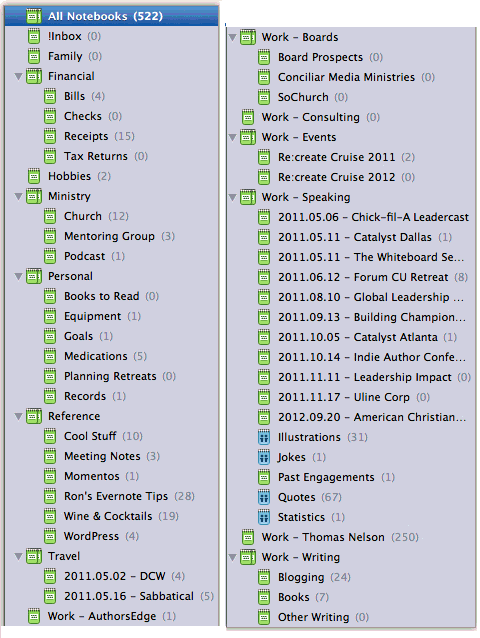Under Construction 
There are several ways to file your notes:A note may have several attributes: domain, type, function, ... (see below). You may pick one or a combination for your primary organizer, although there are metadata features in some systems (e.g. tags in Evernote) that allow you to sort by a secondary category. An alias function on computer filing systems allows you to put a link to a file in one folder in another folder. This function has been requested for evernote, but as of Spring 2013 it didn't exist. In any system a good search function is necessary because there will always be ambiguity as to which category you used. A search function should list matches by title and tag before matches in content. A synonym algorithm is important also. e.g. "CA" = "California" = "Calif." An encryption function is also a good feature.
Attributes: Digital Media: You can use a filing system like Evernote for media, but media specific programs, e.g. iTunes, iPhoto, Kindle app are more appropriate for this. My system in Evernote:
I Contacts
Personal, Family, Organizations, [services-see below]
II Stores-Products-Services
stores, products, services, travel (bus/train/air schedules)
III Info-Ref
Arts (Books, Music, Movies, ...), Politics, Religion, Environment, Science,
IV Help
Computer support/notes, How to/DIY (Home, car, ...)
V Information about my stuff
Purchases (dates, ...), Home (floor plan, garden records, ..),
Electronics (computers, AV)
VI Personal Info
Medical, Correspondence, Travel log, cards-permits,
| |
Some categories:
Personal
Business
Family
Travel
Info or Reference
Help (product/
service notes)
Products
Services
Orgs
Hobbies
Sports
Food
Drinks
Health
Meeting Notes
Presentations
Jokes
Books
Movies
Music
Contacts
|
Other Systems
 Source: How to Organize Evernote for Maximum Efficiency | Michael Hyatt |
|
Tips:
Links: Return to Classification
| |